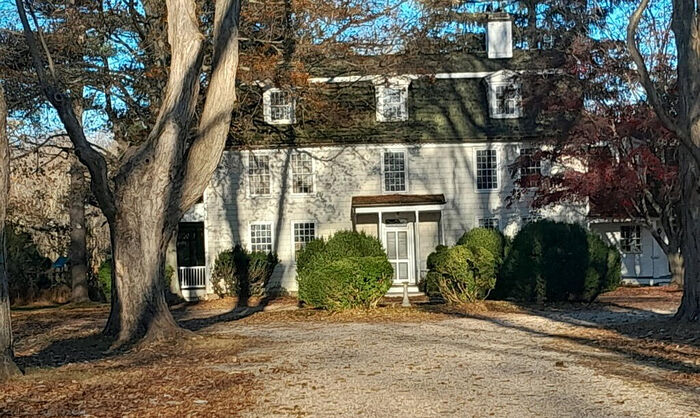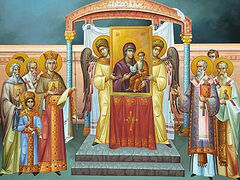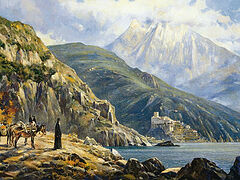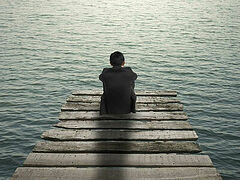Part 1
 —When did you take up iconography?
—When did you take up iconography?
—I started painting icons in around 1998, while I was attending Mercy House. Fr. Joachim Parr, the abbot of Mercy House, asked me to paint a Plaschanitsa for the monastery to use for an upcoming Holy Friday service, so I agreed. That was the very beginning of the journey. This happened towards my completion of graduate studies at Hunter.
At first icon painting didn’t really interest me, since I was immersed in my pursuit of a secular painting career. This changed once monasticism became my path. Iconography then became a major focus, a way of offering and channeling my gifts as a painter within the ecclesial sphere.
—Who played an important role in your becoming a monk and in your spiritual growing as a
monk?
—That’s a very good question. In his mysterious ways the Lord has always provided me with what I’ve needed at any given time, every step of the way, throughout my life. Hence during my formative years of monasticism at Mercy House, Fr. Joachim Parr played a major role as a guide. He was my spiritual father and abbot.
Looking back, you clearly see how the challenging parts—the trials—help you grow spiritually. In the beginning of your conversion, you’re literally a child spiritually, so God keeps you close to His bosom. You really feel a palpable sense of His grace—the transformation that faith brings to your life. And so, along with that, it’s extremely precious when you find someone whom you feel can serve as your spiritual guide. But also, the Lord Himself teaches you how to walk, allowing for you to stumble along, in order to learn how to find the balance. In other words, with trials and growth also come sobriety and discernment—spiritual maturity. You begin to have a more realistic sense of your mentor’s human limitations and how he should ultimately aim to iconize Christ. For it is ultimately Christ who is behind it all, teaching us. We just have to learn to get out of the way.
In any case, Mercy House eventually grew and expanded. Consequently, the brotherhood moved to Treadwell, Upstate New York, where we found land to establish a new monastery called the Savior’s Desert, or Treadwell Abbey. Along with Fr. Joachim and the rest of the brotherhood, I was fortunate to contribute in helping to establish that new location.
That was a big growing experience for me in dealing with the realities of monasticism, not as a romantic abstraction, but rather a concrete life and blood community experience, which reveals your own limitations very realistically, and teaches you how little you know of genuine love. You begin to see how asceticism is not merely about rigorous rules and regulations, but rather about basic Christian love, an overcoming of the self for the sake of the other.
After the Mercy House experience and helping with the establishment of Treadwell Abbey, Metropolitan Hilarion (Kapral; †2022.—Ed.) gave me his blessing to transfer and become part of the brotherhood of Holy Cross Monastery, which at that time was in East Setauket, New York.
The brotherhood changed locations in 2018 and is now called the St. Dionysios the Areopagite Monastery, located in St. James, New York. I have been part of this brotherhood since 2011.
—How would you characterize St. Dionysios Monastery? And how does your iconography work fit in and thrive there?
—Monasticism comes in different styles and has different approaches. On Mount Athos, for example, they have large cenobitic institutions, small sketes, and hermitages. There are also city monasteries, country monasteries and desert wilderness monasteries. Each place has its own typikon, leadership and brotherhood makeup, all of which contribute to giving each its unique flavor and style. The totality of brotherhood as a family becomes the context that shapes the process of spiritual growth.
In Mercy House and Treadwell Abbey most of my time and efforts were put into priestly responsibilities and the everyday labor of establishing a new monastery, such as turning a barn into a church and other construction projects. St. Dionysios Monastery is very different from my former experience. At St. Dionysios I have been fortunate to find more flexibility. We have multiple priests to share the work load, so there’s a better balance between pastoral responsibilities and icon painting. Since I became part of St. Dionysios Monastery, Archimandrite Maximos (Weimar), our abbot, has been generous in supplying me with the freedom and time needed to invest in the pursuit of icon painting and the writing of articles on various aspects of iconography. At the moment the project that needs more attention and completion is the iconography for the iconostasis of our monastery’s chapel.
Our life in the monastery is very simple: services in the morning and in the evening, along with our private cell rules. We have at least two Liturgies a week, depending on the festal cycle. Sometimes we might have three or four Liturgies a week, with Great Vespers and Matins. We have a communal meal most evenings. On Monday morning we rest from the busy weekends, but we have Vespers. The aggregate services during Lent are the longest, extending up to six hours for every day of Clean Week. We primarily follow a Jerusalem style of services, in continuity of our tradition, since for a period of time the brotherhood was under the Jerusalem Patriarchate, and our abbot was mentored by Archbishop Damaskinos of Jaffa.
Our brotherhood mainly consists of seven monastics: four hieromonks—one of whom has priestly responsibilities at the Synod Cathedral—two hierodeacons, and a riassaphore monk. Most of us in the monastery are converts. Archdeacon Michael (Wells), the oldest, is of Ukrainian background and cradle Orthodox. Likewise, Igumen Zosimas (Krampis), who is attached to us, but serves the English language community in St. Sergius Chapel in New York City, is of Greek descent and also cradle Orthodox. At this moment we have two young men residing with us interested in monasticism, helping with various tasks as they discern their calling.
Fr. Maximos always emphasizes that a basic principle of the brotherhood is to allow the priests, deacons and monks, which compose the monastery, to have room for freedom to use their personal gifts for the sake of the community. Not only the monastic community, but also the community of the Church at large.
—You also have a parish community at your monastery, haven’t you?
—The parish community which attends our services is a major component of who we are as a monastery. It could be said that we’re basically a brotherhood that serves a parish community—that’s our mission work. We generally could have up to fifty people on Sunday Liturgies, and an average of 150 people for Pascha. We have a good amount of people from different backgrounds: Greeks, Russians, Ukrainians, Georgians, Romanians, Bulgarians, Serbs, Palestinians, etc. We do the services primarily in English, but we often add some exclamations in Greek, Russian, Romanian, Arabic, even Spanish, depending on who is in attendance.
Right now, services take place in our monastery chapel, which is in fact the large living room of our late eighteenth century house, where the monks reside. We have now reached maximum capacity on Sundays, so we need to build a church soon. Our beautiful property is of a pretty good size, with a wonderful field in front of the house. All the architectural plans are ready. We’re actually in the process of getting permits to start building.
—What challenges does the Mission in Puerto Rico face these days?
—One of the main challenges I see in Puerto Rico is that of catechism. Given the island’s predominantly Roman Catholic population, it’s going to be crucial to help them see the uniqueness of Orthodoxy as the Church of Christ, that it’s not just another version of Catholicism. The many Protestant sects and denominations present in the island don’t help the situation and only add wood to the fire of doctrinal confusion. There’s also Spiritism and Santeria, a form of Voodoo that syncretizes African religion with the veneration of Roman Catholic saints. So, I would say that the process of catechism will continue to be a major challenge, taking much effort and patience.
Another challenge, related to catechism, is the training of young men in the mission, for future ministry as clergymen. But this, of course, depends on the growth of the mission. We need to pray that the Lord send candidates for ordination—gifted, pious, faithful and committed young men, with a calling to the ministry and a desire to continue the work of the mission.
In addition to the catechetical challenge is the problem of Spanish translations. The interesting thing about the Puerto Rico mission is that it’s the only Orthodox community on the island that’s working primarily to bring the faith to the locals in their own language. Fr. Peter Jackson, the dean of the Spanish Missions, has been doing a lot of great work, gradually translating services into Spanish. Some translations of catechetical work were also done by Bishop Alexander (Mileant; †2005) from South America. All of this has been very helpful, but there’s still much more work to be done on this front.
The mission needs all of the service books necessary for a fully functional parish community translated into Spanish. They also need Spanish translations of the writings of the Church Fathers. Anyone who knows of this kind of source material should send it or contact the mission about it. And anyone who is willing to offer their translating skills should contact Fr. Gregory.
The mission is slowly growing, and a building project is in the works. Metropolitan Nicholas of Eastern America and New York visited the mission last year and blessed the grounds where they’re planning to build the new church. The architectural drawings are ready, based on the style of the cemetery chapel at Holy Trinity Monastery in Jordanville. Bishop Luke was contacted and he graciously extended his help to the mission, providing them with information on the architectural design of the cemetery chapel. Thereafter Fr. Gregory and Fr. Daniel visited Jordanville to take measurements and pictures of the chapel, which they later provided to the architect as reference documentation. Throughout this process Fr. Daniel has been instrumental in providing administrative help to Fr. Gregory. He also has helped greatly with the choir in the mission.
—How do you personally contemplate the missionary work in Puerto Rico?
—It is like a seed. First, the seed is buried and seems to die, but then it grows. It takes a long time for the seed to become transfigured into something else. Perhaps it will be the same with my father’s work in Puerto Rico; and the work of others, who have and continue to contribute to the mission’s development. It’s not something that my father will necessarily see, in its full growth and bloom, during his lifetime. But I think that the seeds have and are still being planted, in a way that they will bear fruit. Now the challenge for us is to see that they’re watered.
My challenge on a personal level is that since I’m not with my father, this could become perhaps a kind of neglect on my part towards his mission work. But the reality is that I don’t have the kind of missionary calling he has; it’s just not the path I’ve taken. My mission work right now is in the monastery. Nevertheless, I still think that there’s place for me to help. In the future, when the Church in Puerto Rico is ready, I’ll have to help somehow with the iconography. We’ll just have to see what else God might have in store.
Another major way to help, although very simple and very often taken for granted, is to pray for the mission. Mission work, let’s not forget, entails a spiritual battle. Recently, during our monastery’s patronal feast in October, Protodeacon Paul Wolkow, from St. Seraphim Memorial Church in Sea Cliff, New York, said something very important during his congratulatory trapeza toast. He reminded us that now that we were getting closer and closer to building our new monastery church, there would be different kinds of trials, that the devil would do everything and anything possible to see that it doesn’t happen. That’s something we need to keep in mind—that the devil doesn’t want any kind of missionary work to take hold in any place, whether it be here in the US or in Puerto Rico. There are always going to be trials that unfold in the community, tests threatening progress and the realization of potentially fruitful work.
Therefore prayers, prayers asking for peace, oneness of mind and mutual love in the community, are essential. For only through mutual love and self-giving within the community will anything flourish and unfold in the right direction, since it will be stamped with the grace of the Holy Spirit, in cooperation with Christ. But if it’s not functioning on this level, it will then be extremely difficult, because the human component will be constantly getting in the way, creating unnecessary problems. That’s inevitably the way we are in our human frailty. The battle takes place inside, within the heart, and inevitably ripples outward. We have to be in a state of prayer to keep ourselves in check, humble ourselves and cooperate with God. This is the case whether it be in the family, monastery, mission, or parish context. Basic, but hard.











